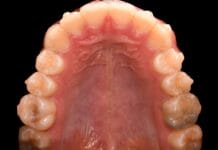Early childhood caries (ECC) has persistently plagued children for decades. In 2017, untreated ECC was estimated to be the tenth most prevalent condition globally, affecting 532 million children worldwide. Evidence supports the use of sodium fluoride (NaF) varnish to prevent dental caries and arrest incipient lesions. While, silver diamine fluoride (SDF) has shown effectiveness in remineralizing dentin caries in primary teeth with an estimated success rate ranging from 65% to 91%.1
A research team designed a randomized field trial to assess the difference between the use of SDF alone or in combination with NaF varnish in arresting dentin caries in a pediatric cohort. The research team hypothesized that there would be no significant difference in ECC arrest between the two interventions.1
The Study
Children were eligible to participate in the study if they were healthy and four years old or younger, with at least one active carious lesion on a primary tooth categorized with International Caries Detection and Assessment System (ICDAS), codes 3 and above (ICDAS 3 or 4 = moderate lesions and ICDAS 5 or 6 = advanced lesions).1
Exclusion criteria included teeth with spontaneous or elicited pain due to caries and any signs of pulpal infection, swelling, or abscesses. Additionally, children with allergies to silver or any materials used in the study were excluded.1
All eligible teeth for each child were included in the study. The children were randomly assigned to one of two groups with an equal allocation ratio of 1:1. The control group received a 38% SDF solution alone. The test group received the same 38% SDF solution as the control group along with 5% NaF varnish.1
The study included 220 children and a total of 1,606 lesions. Out of these, 749 lesions in 110 children were treated with SDF + NaF, while the remaining 857 lesions in another 110 children were treated with SDF alone.1
The Results
The percentage of arrested lesions was significantly higher in the SDF + NaF group compared to the SDF group for all lesions (77.7% vs. 73.2%, p = 0.04) and for moderate lesions (88.9% vs. 74.3%, p < 0.001), but not for advanced lesions (73.9% vs. 72.8%, p = 0.37).
SDF + NaF had a significantly greater arrest effect for moderate lesions than SDF alone. Although SDF + NaF showed a greater effect than SDF alone for severe lesions, the difference was not statistically significant (p = 0.08). Overall, the study demonstrated that combining SDF + NaF resulted in significantly higher arrest rates for all lesions, especially for moderate lesions. However, this superior effect was not observed in advanced lesions.1
This study had a few limitations, including a follow-up period of only six months. Future studies could extend this duration to longer periods to validate the current findings. Additionally, the lack of radiographic examinations due to field conditions may have led to some lesions being misdiagnosed.1
Conclusion
Further studies are necessary in clinical settings to include radiographic assessments of lesion progress, particularly among young children and those with special needs, where this intervention could be beneficial. This would complement the current study, which focused on children from disadvantaged backgrounds in field conditions.1
Additionally, more research is needed to evaluate the impact of both treatments on caries progression, the reduction of new carious lesions beyond the treated areas, and their cost-effectiveness over longer periods. This information would assist in determining whether combining SDF and NaF varnish is a viable strategy for preventing ECC based on the stage of lesion progression.1
Overall, the study demonstrated that the combination of SDF and NaF varnish was more effective in arresting ECC lesions than SDF alone, particularly in moderate lesions. However, the difference was not significant for advanced lesions. Parental satisfaction with their children’s appearance did not differ between the two groups. These findings have important implications for the non-invasive management of ECC in field conditions, addressing the dental care needs of disadvantaged children in rural communities.1
Before you leave, check out the Today’s RDH self-study CE courses. All courses are peer-reviewed and non-sponsored to focus solely on high-quality education. Click here now.
Listen to the Today’s RDH Dental Hygiene Podcast Below:
Reference
1. Abdellatif, E.B., El Kashlan, M.K., El Tantawi, M. Silver Diamine Fluoride With Sodium Fluoride Varnish Versus Silver Diamine Fluoride in Arresting Early Childhood Caries: A 6-Months Follow Up of a Randomized Field Trial. BMC Oral Health. 2023; 23(1): 875. https://bmcoralhealth.biomedcentral.com/articles/10.1186/s12903-023-03597-5











